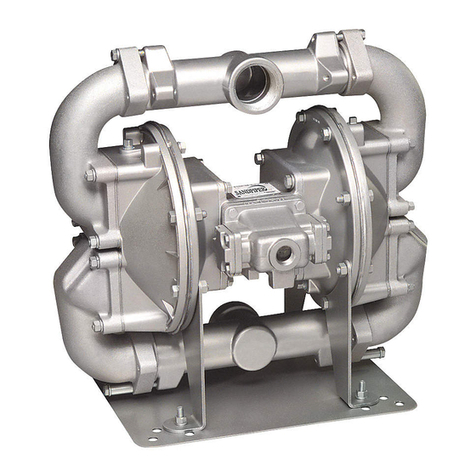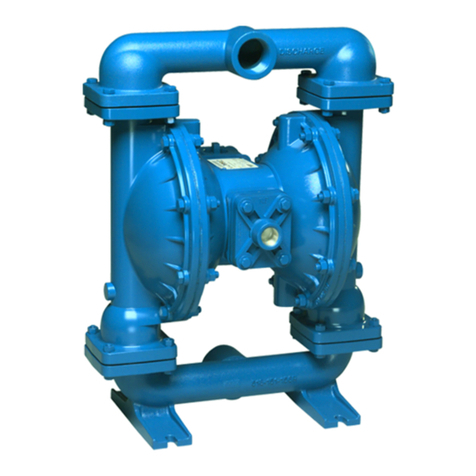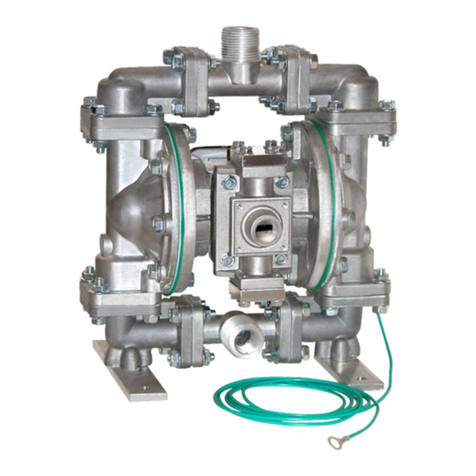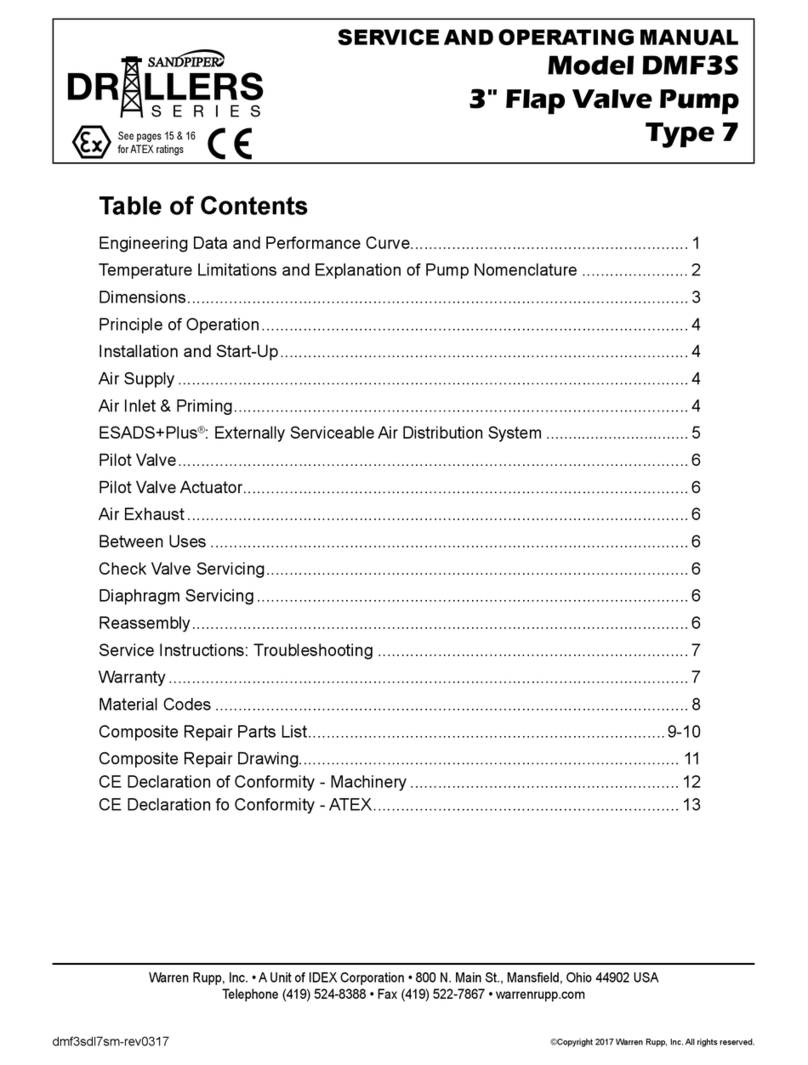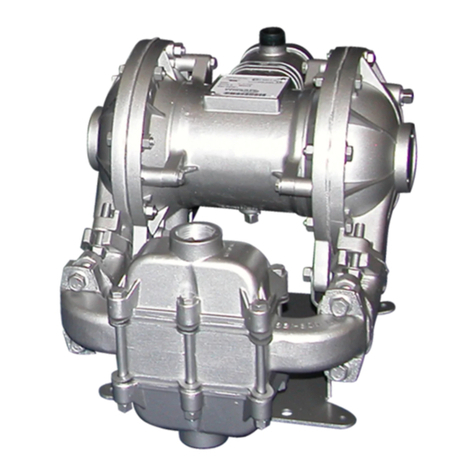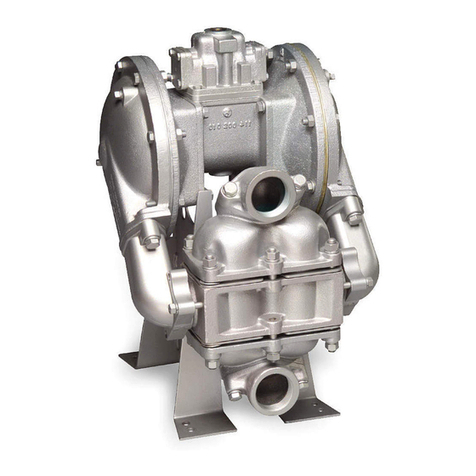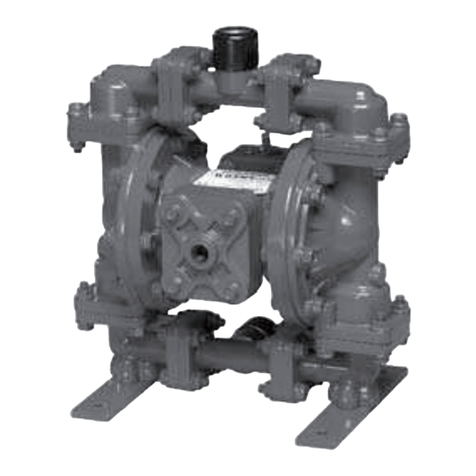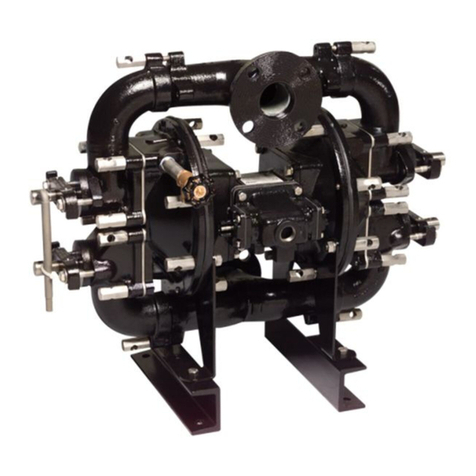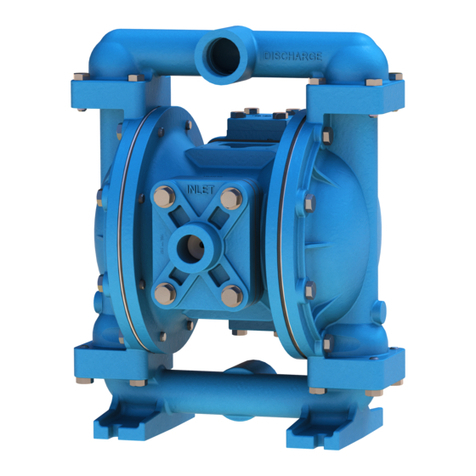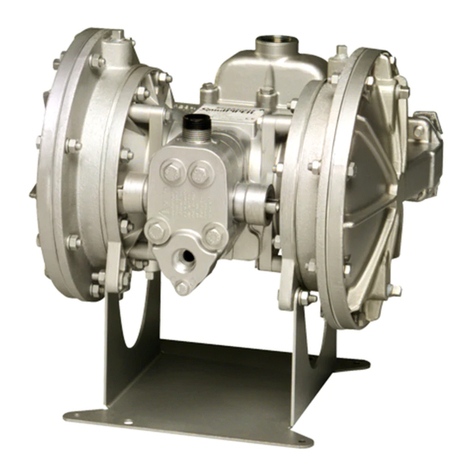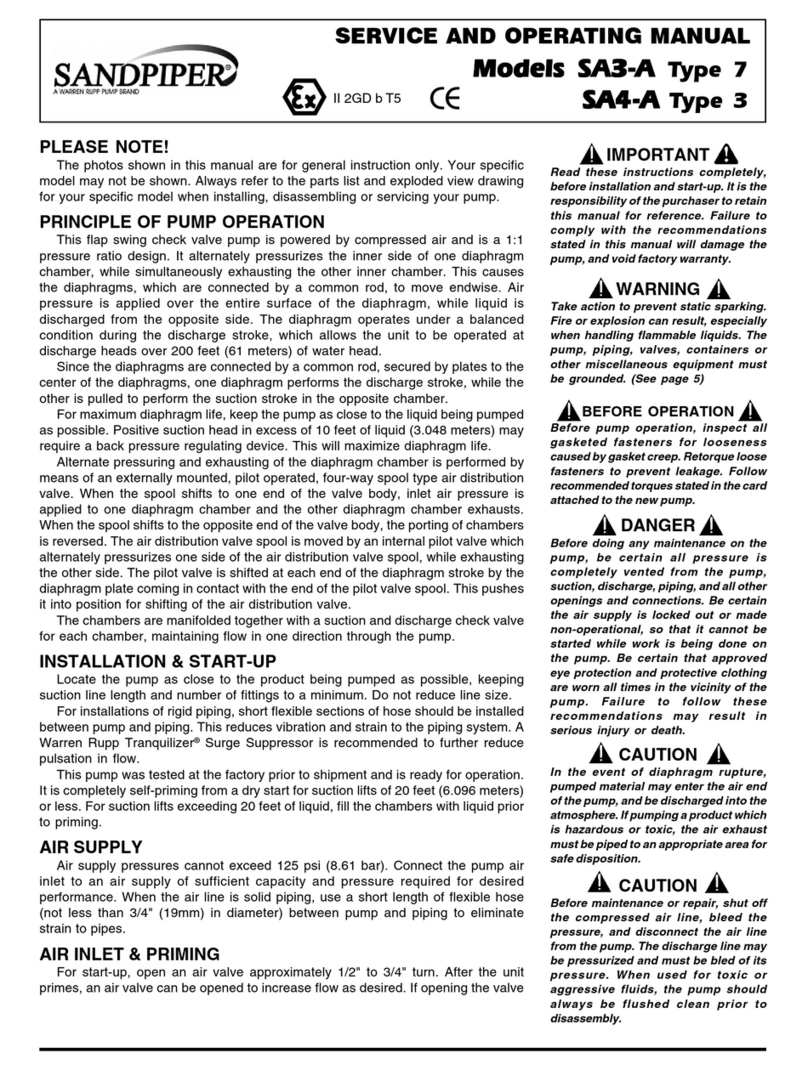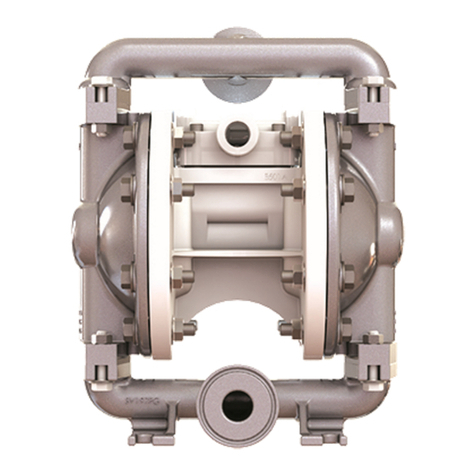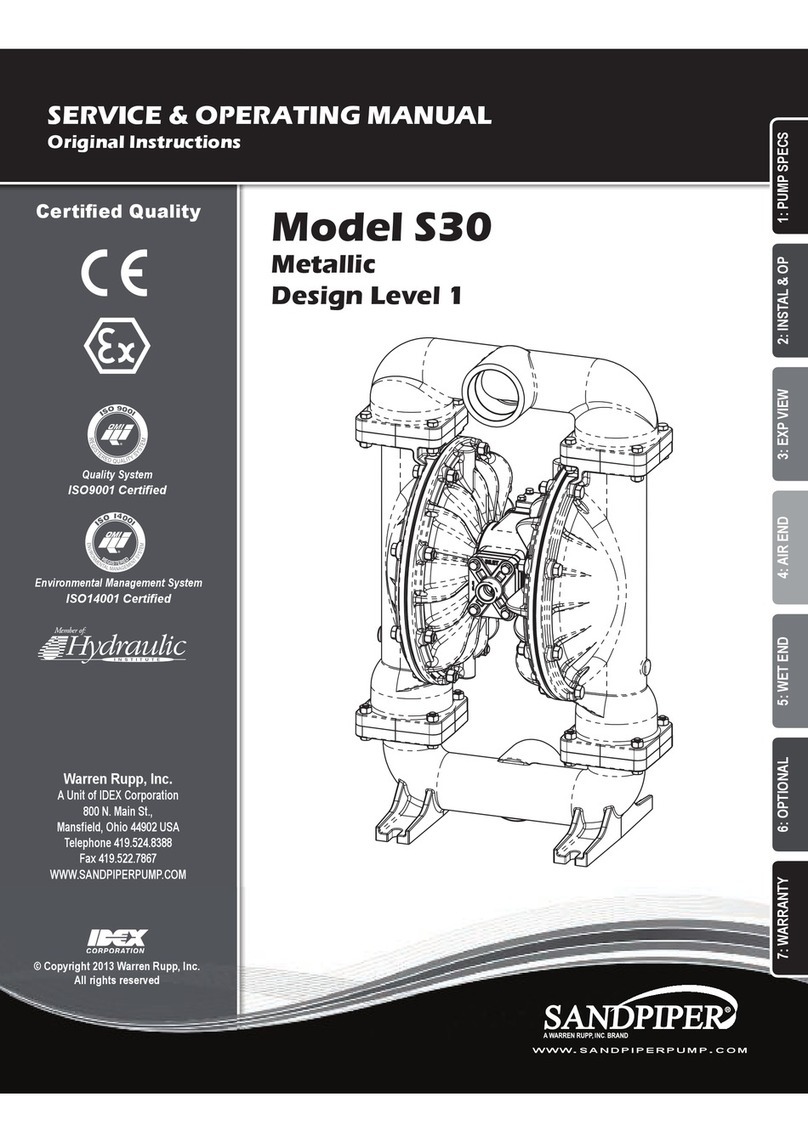
Models SB1-A & SB25A Type 4 Page 4 520-146-000 7/03
inspection or replacement. First remove the air distribution valve body and the pilot
valve body from the pump. The plungers can be located by looking into the
intermediate. It may be necessary to use a fine piece of wire to pull them out. The
bushing can be turned out through the inner chamber by removing the outer
chamber assembly. Replace the bushings if pins have bent.
SERVICE INSTRUCTIONS: TROUBLE SHOOTING
1. Pump will not cycle
A. Check to make sure the unit has enough pressure to operate and that the air inlet
valve is open.
B. Check the discharge line to insure that the discharge line is neither closed nor
blocked.
C. It the spool in the air distribution valve is not shifting, check the main spool. It must
slide freely.
D. Excessive air leakage in the pump can prevent cycling. This condition will be
evident. Air leakage into the discharge line indicates a ruptured diaphragm. Air
leakage from the exhaust port indicates leakage in the air distribution valve. See
further service instructions.
E. Blockage in the liquid chamber can impede movement of diaphragm.
2. Pump cycles but will not pump
A. Suction side of pump pulling in air. Check the suction line for air leaks and be sure
that the end of the suction line is submerged. Check flange bolting. Check valve
flanges and manifold to chamber flange joints.
B. Make certain the suction line or strainer is not plugged. Restriction at the suction
is indicated by a high vacuum reading when a vacuum gauge is installed in the
suction line.
C. Check valves may not be seating properly. To check, remove the suction line and
cover the suction port with your hand. If the unit does not pull a good suction
(vacuum), the check valves should be inspected for proper seating.
D. Static suction lift may be too high. Priming can be improved by elevating the
suction and discharge lines higher than the check valves and pouring liquid into
the unit through the suction inlet. When priming at high suction lifts or with long
suction lines operate the pump at maximum cycle rate.
3. Low performance
A. Capacity is reduced as the discharge pressure increases, as indicated on the
performance curve. Performance capability varies with available inlet air supply.
Check air pressure at the pump inlet when the pump is operating to make certain
that adequate air supply is maintained.
B. Check vacuum at the pump suction. Capacity is reduced as vacuum increases.
Reduced flow rate due to starved suction will be evident when cycle rate can be
varied without change in capacity. This condition will be more prevalent when
pumping viscous liquids. When pumping thick, heavy materials the suction line
must be kept as large in diameter and as short as possible, to keep suction loss
minimal.
C. Low flow rate and slow cycling rate indicate restricted flow through the discharge
line. Low flow rate and fast cycling rate indicate restriction in the suction line or air
leakage into suction.
D. Unstable cycling indicates improper check valve seating on one chamber. This
condition is confirmed when unstable cycling repeats consistently on alternate
exhausts. Cycling that is not consistently unstable may indicate partial exhaust
restriction due to freezing and thawing of exhaust air. Use of an air dryer should
solve this problem.
For additional information, see the Warren Rupp Troubleshooting Guide.
WARRANTY
This pump is warranted for a period of five years against defective material and
workmanship. Failure to comply with the recommendations stated in this manual
voids all factory warranty.
IMPORTANT
This pump is pressurized internally with
air pressure during operation. Always
make certain that all bolting is in good
condition and that all of the correct
bolting is reinstalled during assembly.
CAUTION
In the event of diaphragm rupture,
pumped material may enter the air end
of the pump, and be discharged into the
atmosphere. If pumping a product which
is hazardous or toxic, the air exhaust
must be piped to an appropriate area for
safe disposition.
CAUTION
Before maintenance or repair, shut off
the compressed air line, bleed the
pressure, and disconnect the air line
from the pump. The discharge line may
be pressurized and must be bled of its
pressure. When used for toxic or
aggressive fluids, the pump should
always be flushed clean prior to
disassembly.
WARNING
Take action to prevent static sparking.
Fire or explosion can result, especially
when handling flammable liquids. The
pump, piping, valves, containers or
other miscellaneous equipment must
be grounded. (See page 5)
WARNING
The weight of the air supply line and of
the filter must be supported by some
means other than the air valve cap.
Failure to provide support may result in
damage to the pump.
RECOMMENDED WARREN
RUPP ACCESSORIES TO
MAXIMIZE PUMP
PERFORMANCE:
• Tranquilizer®Surge Suppressor.
For nearly pulse-free flow.
• Warren Rupp Filter/Regulator. For
modular installation and service
convenience.
• Warren Rupp Speed Control. For
manual or programmable process
control. Manual adjustment or
4-20mA reception.
For more detailed information on
these accessories, contact your local
Warren Rupp Factory-Authorized
Distributor, or Warren Rupp
corporate headquarters.

